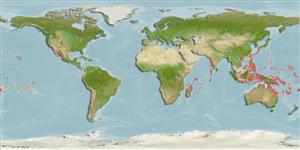Malacostraca |
Decapoda |
Xanthidae
Environment: milieu / climate zone / depth range / distribution range
Ecology
Reef-associated; depth range 0 - 6 m (Ref. 96667). Tropical
Indo-Pacific.
Length at first maturity / Size / Weight / Age
Maturity: Lm ? range ? - ? cm
The smooth carapace is covered with lacework pattern. The pair of pincers is equal in size with black tips (Ref. 128968).
Found in shallow beaches. The smooth carapace is covered with lacework pattern. The pair of pincers is equal in size with black tips (Ref. 128968). This species contains paralytic shellfish toxins (PST) which are considered lethal when ingested by humans (Ref. 107779). Found along the neritic zone (Ref. 97241), on fringing reefs (Ref. 81564). Intertidal to subtidal (Ref. 106854).
Life cycle and mating behavior
Maturity | Reproduction | Spawning | Eggs | Fecundity | Larvae
Members of the order Decapoda are mostly gonochoric. Mating behavior: Precopulatory courtship ritual is common (through olfactory and tactile cues); usually indirect sperm transfer.
Tweedie, M.W.F. 1950 A collection of crabs from Aor Island, South China Sea. Bulletin of the Raffles Museum 21:83-96. (Ref. 81564)
IUCN Red List Status
(Ref. 130435: Version 2025-1)
CITES status (Ref. 108899)
Not Evaluated
Not Evaluated
Threat to humans
Poisonous to eat (Ref. 107779)
Human uses
| FishSource |
Tools
More information
Trophic EcologyFood items (preys)
Diet composition
Food consumption
Predators
Population dynamicsGrowthMax. ages / sizesLength-weight rel.Length-length rel.Length-frequenciesMass conversionAbundance Life cycleReproductionMaturityFecunditySpawningEggsEgg developmentLarvae PhysiologyOxygen consumption
Human RelatedStamps, coins, misc.
Internet sources
Estimates based on models
Preferred temperature
(Ref.
115969): 24.7 - 29.2, mean 28.3 (based on 2649 cells).
Price category
Unknown.
